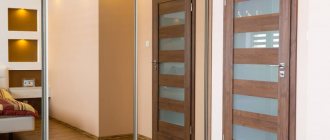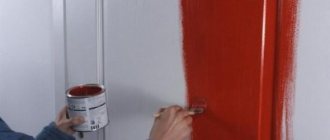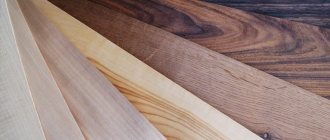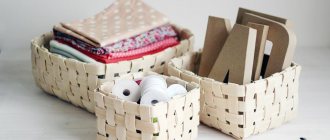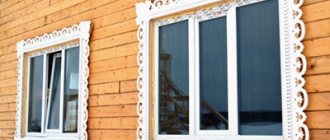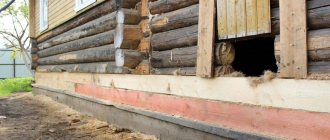Each interior door has platbands installed that play a decorative role, giving it a complete image. They have different shapes, colors, and are also attached using different methods. The main thing to remember is that installing trim on interior doors is done with your own hands only after the finishing of the walls has been completed. We will discuss in detail how and what to do in our article.
General rules for installing doors
A door block is a prefabricated structure consisting of a frame, a leaf, installation and connecting units, and fittings.
The box is mounted in the opening and consists of vertical profiles and a crossbar. The sash is installed on one of the profiles using hinges. The profiles are made of durable wood. Sometimes the box is supplemented with a threshold and seal for sound and thermal insulation. In installer slang, a door frame is called a “ludka”.
A movable panel made of wood, veneered with MDF, PVC or metal, closes and opens the opening. Lightweight frames with honeycomb filling or reinforced frames made entirely of wood are sold.
Component elements include platbands and extensions. Framing strips perform a decorative function and cover the joints of the canvas and the box. Extensions cover slopes and joints with walls. Elements come in a special format: for decorating arches and non-standard doorways.
The category of fittings includes all possible latches, handles, hinges, and crossbars. This group includes door closers, opening angle limiters, seals
.
To install a door system yourself, you need tools and basic skills. The quality of installation is affected by the accuracy of measurements: from minimal misalignment of parts, system defects will appear in the future: cracks will form or jamming of the canvas.
The dimensions of the frame must be smaller than the size of the opening, otherwise it will need to be expanded. Professionals consider the optimal size of gaps to the wall to be 10-40 mm.
Door blocks are presented on the construction market in disassembled or assembled format. In the first case, the installer's work will be more complex and time-consuming, since the box will need to be assembled.
The general procedure for attaching an interior door frame looks like this:
- Installation of a disassembled box.
- Equipping all elements of the door block with the necessary fittings, fastening the door leaf to hinges.
- Installing the frame: the door frame is fixed in the opening using hangers or anchors, the gaps are filled with foam
- The sash is hung on the fixed “bowl” and adjustments are made.
- Platbands and extensions are installed.
Platbands are a mandatory decorative element of the door structure to design the opening around the entire perimeter. Extensions are purchased if the opening in depth exceeds the dimensions of the frame. The protruding surface of the wall is hidden under decorative strips.
Dismantling
Removal of platbands is usually required when cash is replaced. There is no need to worry about their safety, but the work is done carefully. Taking an ax with a sharp blade and a hammer in their hands, they begin to dismantle:
- To remove the trim carefully, the interior door is placed in an open position. Positioned in the doorway, the tip of the ax is inserted in the upper corner between the bar and the frame.
- The hammer is used to hit the butt of the ax until the blade plunges under the cash.
- By pressing the handle on the ax, the bar is separated from the box. The further procedure consists of similar actions. They use an ax in a circle until the dismantling of the platbands is completed completely.
The procedure must be carried out carefully so that no dents are left on the door frame. Instead of an axe, homemade sharpened strips of durable metal or other similar devices are suitable.
Main types of platbands
Door trims vary in installation method, material of manufacture, shape, color and style. The type of product determines the choice of further installation method. Different materials are used to produce parts:
- tree;
- metal;
- MDF;
- PVC.
MDF trims are considered the most popular and budget-friendly for finishing interior doors. The undoubted advantage of wood planks is that they can be installed using any type of fasteners.
Varying in style and shape, the planks are:
- straight (flat);
- with bevel;
- teardrop-shaped;
- rounded (semicircular);
- carved and figured;
- typesetting.
An additional element is sometimes installed above the top bar - a capital. Occasionally, the part is used for the lower part of the door frame. The detail plays a deliberately decorative role and is appropriate only for rooms in a classical style.
Based on the method of fastening, the planks are usually divided into overhead and telescopic. The first format is fixed using the chosen method directly to the surface of the door frame, the second is equipped with mounting grooves.
Why are they needed?
The main decorative task of the platband is to make the point of contact between the window frame and the wall attractive. But it also has more practical functions: it prevents sunlight, wind, and moisture from affecting the connecting seam, which means it protects the polyurethane foam from the weathering process.
Varieties
I'll start with the typical option - flat. A budget offer that pleases not only with its affordable price, but also with the simplest installation scheme. When the appearance of the facade is not required to evoke a surge of emotions, installing a flat platband is the best solution.
Platbands with a profiled interior have some kind of convexities that retain their shape in frost, heat or increased humidity. There are many options with different patterns, so choose what you like - everyone will have the same impeccable quality.
But remember that you will have to trim and align at the corners, so be careful about your strength.
I do not recommend choosing carved frames if the design is clearly discordant with the overall style of the task. If you can’t find the trim of the desired color, don’t rush to buy something from the assortment available in the nearest stores - look in those further away. Or use the Internet - today there are a lot of color options, so it is still possible to find the desired color of the trim.
What are they made from?
Sheet monolithic or structured plastic is the most popular material in the production of flat products. It tolerates temperature fluctuations well, does not lose quality under prolonged exposure to ultraviolet radiation, and is not afraid of moisture. When mixed with pigments, a high-quality colored base is obtained, so there are almost no problems with selecting the trim of the desired color.
Plastic almost does not elongate unless it is exposed to extremely high temperatures (they do not happen in everyday life). It does not change its given shape even under the influence of water. Therefore, plastic structures do not provide gaps, which are necessary when working with other materials.
Polyurethane (PVC) platbands are most often embossed. The properties of the material make it possible to translate any design ideas into real forms, and to use finished products on facades and indoors.
High-quality flat or embossed MDF trims will enchant anyone with their beauty. But I recommend installing them only indoors - the products become deformed during prolonged contact with a damp environment, so this is not the most practical option for outdoor use. Of course, no one can prohibit it. But will everyone raise their hand to personally send a beautiful frame, and an expensive one at that, for sure to be deformed?
For dessert I left the trim made of natural wood. Profiled, flat, shaped - any are good. Even in the absence of hand or machine carving. But if during production the manufacturer deviated from the technology or got tricky with the finishing process, then you won’t be able to admire the beauty for very long. After a year or two, deformation will begin and the canvas will begin to crack.
When choosing platbands, focus on your capabilities, the final price of the product and the functionality declared by the manufacturer. Don’t buy something cheap, but it’s also not worth paying through the nose if you are not sure that the purchase will last for at least a decade without losing its original appearance.
Technology for installing platbands in the video:
How to attach platbands?
You can install the platband on a PVC window yourself, using the most appropriate mounting option in your case.
If you like to follow the beaten path, mount the elements on the PVC frame itself or on the wall next to it - these are the most popular ways of attaching cladding panels. If you choose removable elements, then do not rush to firmly attach them with self-tapping screws or anything else - look for latches on the products. But in order for the panels to hold, special metal elements will need to be placed on the frame. Then click-click and you can decorate the window; you’re tired of the trim - take it off in five minutes and that’s it. It's faster to just stick it on with double-sided tape. But such decorations will only last until the first strong wind.
Rules for marking and processing platbands
Installation is carried out after finishing the walls, but before laying the floor plinth.
Preparation of planks consists of correct marking and quality cutting. Vertical trims must be of equal length and correspond to the dimensions of the door frame and opening. When cutting a horizontal crossbar, a small margin is left for perfect adjustment of the corners.
To cut trim made of wood or MDF, you need to use a miter saw. The cut should be made from the reverse side of the product. This method will avoid unevenness and chips. The cut is made using a miter box. Docking at an angle of 45° allows you to join the fragments together perfectly evenly, leaving no gaps.
When marking, lines are drawn with a pencil or a special marker. It is important that the markings are easily erased and not absorbed into the top layer of the material.
Also common is the option of installing platbands at an angle of 90 degrees with an imitation of a lintel. In this case, the elements are used in a flat shape. When marking, the vertical casing is extended by the width of the horizontal one. The cut areas are painted over with paint or varnish to match the color.
Reasons for different materials
The reasons for the appearance of the defect in question depend on the materials used:
- Wood, solid wood planks. Most often, pine is used. Such platbands often come off and become deformed when using wood with high residual moisture. In this case, as the material dries, the material shrinks, which causes a defect. They say: the tree is drying out.
- MDF. This material is the most popular. This wood-based material retains many of its advantages, superior in density. It is important that it does not shrink. At the same time, MDF has low moisture resistance. With high humidity in the room, it swells and is susceptible to rotting. This causes it to move away from the wall and frame, as well as deformation.
- Plastic. Given the popularity of plastic doors, the demand for plastic trim, especially PVC, is increasing. Such elements can come off as a result of material aging, exposure to elevated temperatures, and mechanical stress. He is not afraid of moisture.
Proper installation is important for all materials. The use of low-quality glue or improper fastening with self-tapping screws (nails) increases the risk of the casing coming off during the operation of the door.
Methods of attaching platbands to interior doors
To attach platbands to interior doors, 4 common installation methods are used. The following materials are used:
- nails;
- self-tapping screws;
- special glue “liquid nails”.
The installation of parts using the tongue-and-groove joint principle is widely used.
Door trims for compartment doors have no external and functional differences from the finishing of a regular swing frame. They have standard widths and similar fastening methods.
Using finishing nails
Using nails to install platbands is the most traditional method. To disguise fasteners, special small finishing nails with mini-hats are used.
To properly fix the parts, you need to align them using a level. Given the microscopic size of the caps, it is important not to damage the surface of the planks themselves. For hammering, it is better to use a small hammer, and lightly mark the joints in advance with the tip of an awl.
Hammered nails are well masked with mastic or grout of a suitable shade. Light damage to the planks can be painted over with paint, a pencil or even a felt-tip pen.
Application of liquid nails
Installing platbands with liquid nails is considered a quick and simple method of fastening. The rigid adhesive composition provides high-quality adhesion to any surface.
First, the correct position of each part is determined. Then a small amount of liquid nails is applied pointwise to the back side of the casing. When pressing, you need to make sure that the glue does not bleed through. If this happens, you need to fix it immediately to avoid spreading; usually only a few dots are applied to the bar.
You can combine the two methods and install the casing first with liquid nails, and then secure it with finishing nails. The combination of fasteners will give the door structure additional strength.
Use of self-tapping screws
Long-term operation without nails will be ensured by installing platbands using self-tapping screws. For wooden planks you will need self-tapping screws about 2-2.5 cm long, a screwdriver or screwdriver, and an electric drill with a wood attachment.
The hole points are marked on the strip in increments of 50 cm. The head of the self-tapping screw must be recessed into the surface. On the front side of the cash, the hole is expanded with a nozzle of a larger diameter to a depth of 1–1.5 mm. Tighten the screws so that the cap is immersed in the recess as much as possible. Then the place of fixation is masked or tinted.
Using clasps with a latch
Snap-on trims are also called telescoping or “beak trims.” The peculiarity of fastening telescopic platbands for interior doors lies in the provided design. To connect the elements, the “tenon and groove” principle applies: the protrusion of the strip is tightly attached to the groove of the door frame, then by adjusting the size of the recess, the required distance is set.
The disadvantage of installation with “beaks” is the inevitable gradual delamination of the structure. Over time, the platbands begin to loosen at the joints. In the future, there may be a need for additional adhesive reinforcement.
Invoices
An overlay platband is the simplest option.
It is a strip that closes the gap between the door frame and the wall in the plane of the wall. Such a casing may come off for various reasons:
- Most often, the clypeus comes off in the absence of reliable fixation. A gap may appear between it and the wall or door frame. During the installation process, an insufficient number of fasteners may have been installed or they may not be of sufficient length. In addition, it is possible that the fastening elements have become damaged during operation (for example, nails have rusted).
- Even if properly secured, the trim strip can come off if the door is slammed hard when closing or opened too hard, as well as if there is mechanical impact on the door (impacts). The casing is not designed for significant mechanical loads and vibration.
- Deformation of the plank. It can occur when the material swells from excessive moisture or shrinks when dried.
- Insufficiently reliable fastening of the door frame or extension. With even small displacements (oscillations), the overlay strip gradually loses its bond with the wall surface, forming a gap.
Depending on the causes and size of the gap, measures are taken to replace or secure the overhead trim.
Some nuances when installing a decorative door element
Experienced professionals installing interior doors willingly share their secrets on the Internet. We offer a few simple tips that will greatly simplify the process of installing finishing parts and help you avoid mistakes and defects:
- You should not perform fastenings in small increments of 10-15 cm. To properly secure a two-meter casing, 5 mounting points are enough.
- If flaws and gaps are visible at the joints, they can be filled with sealant.
- The width of a standard platband is usually 12 cm. If the overlay cannot cover the problem area with its dimensions, the products are ordered according to individual measurements.
- The vertical platband should reach the floor itself, and not rest against the baseboard. If you do not follow this rule, the installation will look unaesthetic.
- Plastic skirting boards have decorative plugs for proper connection with other parts, including platbands.
- Sliding doors, when closed, partially cover the cash flow, so you should not purchase narrow slats; it is better to install them as wide as possible.
How to join a plinth with cashing?
The joining of the plinth to the platband can be done in different ways. A neat joint can be made in one of two ways:
- Classical. The plinth is adjusted to the platband, cut and fastened.
- Non-standard. The connection is made with a cut at an angle of 45 degrees to the floor.
The joining option must be selected taking into account the thickness of the wall and the platband. If the thickness of the strip is less than the door lining, then a non-standard method is used.
Features of installing extensions
In order to install high-quality extensions, you first need to accurately calculate the dimensions of the door structure. Measurements are taken from the box to the edge of the wall, top, bottom and middle: the width of the additional parts will correspond to the maximum value.
If the platbands are telescopic, then you will need such a number of strips that their total width is the required value. The elements must be made of the material that makes up the remaining fragments of the door system and match in color.
Installation work is carried out in the following sequence:
- the product is cut in accordance with measurements;
- the door frame is cleaned;
- the upper additional part is being installed;
- polyurethane foam is blown into the gaps;
- side additional elements are installed.
Self-tapping screws are used to secure the finish. Mounting holes with visible screw heads are decorated with plugs to match the additions.
Telescopic
The telescopic platband has a more complex L-shape and is attached by connecting using a tongue-and-groove system on the door frame or directly on the door frame.
It not only masks the gap, but also closes the step that occurs when the thickness of the wall exceeds the thickness of the box along with the extension. This connection system increases the reliability of the element, but the telescopic trims are also capable of moving away with the formation of cracks. Taking into account the specific design, in addition to the specified circumstances, the cause of the defect is the incorrect insertion of the edge of the platband into the groove of the additional element or door frame. Most often, the problem occurs when cutting a groove yourself. It is important that its width matches the thickness of the edge of the step of the casing. A groove that is too wide simply will not fix the platband.
No less important is the accurate calculation of the width of the side shelf of the platband - its main strip should fit snugly against the wall. This is achieved by selecting the thickness of the extension. It is best to use a special additional element that already has a groove for the platband.
Elimination of defects
Even with experience and skills in decorative finishing of doorways, you can make annoying mistakes. The following tips will help disguise minor installation defects.
1. If the wall is uneven, the wooden frames may bend and the joints may diverge. To avoid this, during installation the joint is additionally secured with a finishing nail.
2. Significant defects in the wall around the door frame are covered with wide planks (10-12 cm).
3. To disguise nails when installing planks of unsaturated colors, it is good to use light furniture wax or sealant of the appropriate shade.
Tools for work
Before you begin attaching interior door frames, check in advance that you have the necessary tools and parts at hand. To finish the door structure you will need:
- drill (screwdriver);
- screwdriver;
- small hammer;
- self-tapping screws;
- finishing nails with small heads;
- fixing glue “liquid nails”;
- wood drill with different attachments;
- pencil or marker for marking (erasable).
These items are enough to install the trim using one of the installation methods. Naturally, each fastening method and specific products require that the necessary tools be at hand.
Did you manage to solve your problem using the recommendations from the article?
Yes!
46.43%
No. More answers required. I'll ask in the comments now.
38.42%
Partially. There are still questions. I'll write in the comments now.
15.14%
Voted: 799

